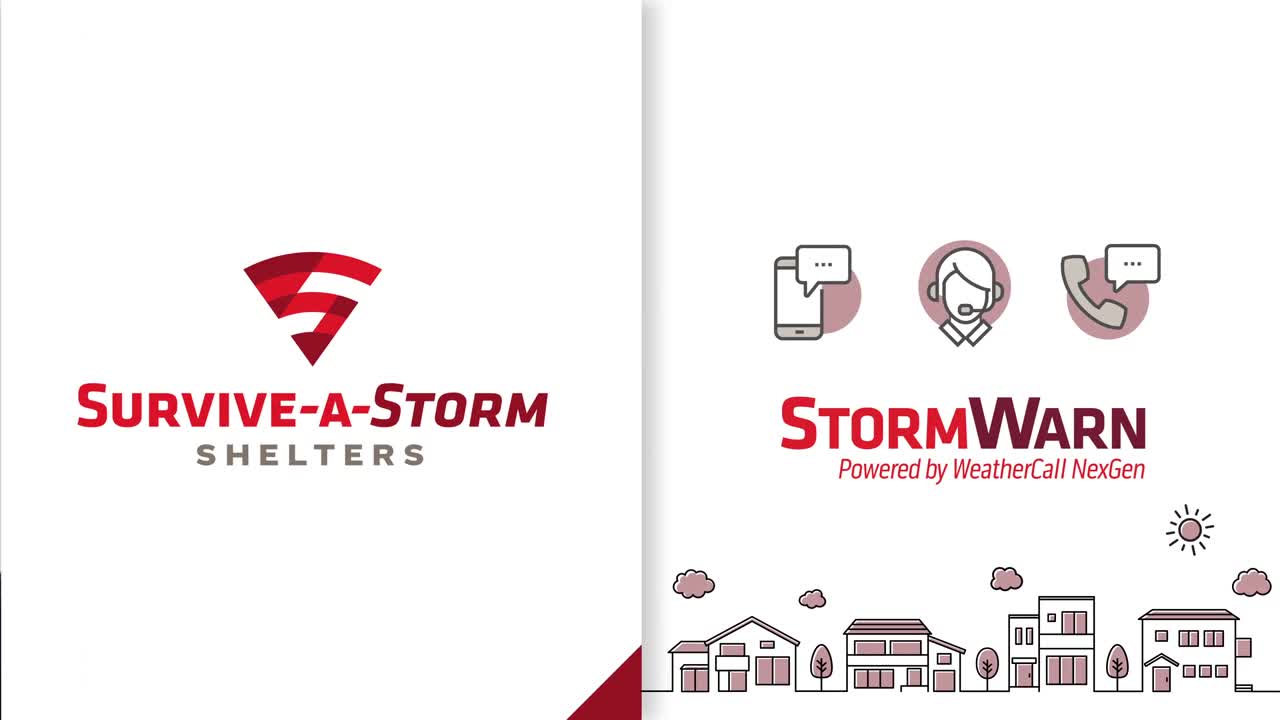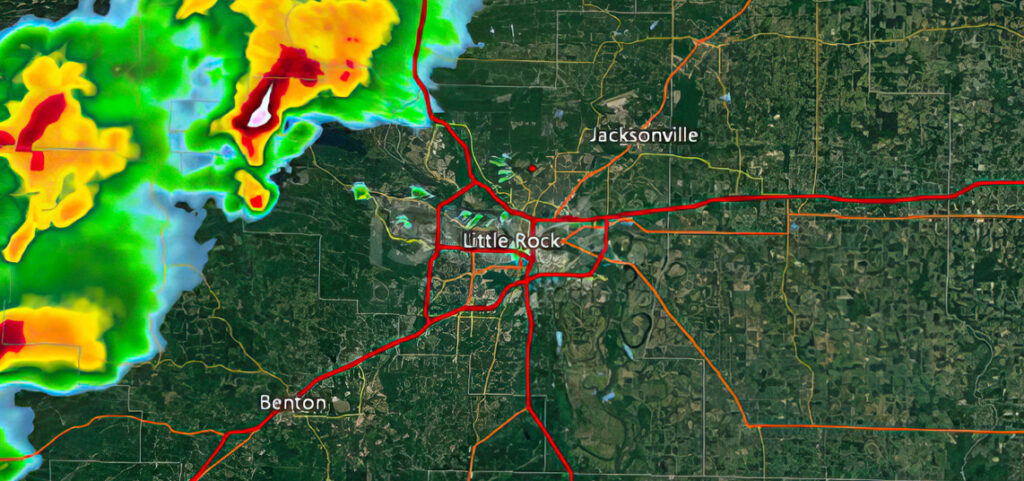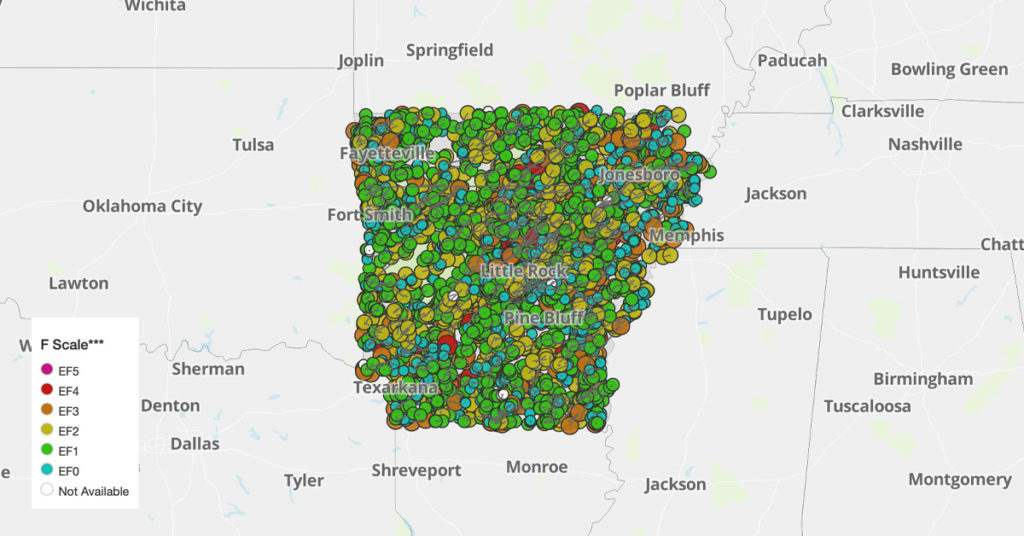Arkansas, with an average of 31 tornadoes per year, is part of the region known as Tornado Alley, which stretches from Texas to South Dakota and is known for its high frequency of tornadoes. Here are some more facts about tornadoes in Arkansas.
- Arkansas is one of the states with the highest tornado frequency - they are most common during the months of March, April, and May, when warm Gulf air collides with cooler northern air. But tornadoes can occur outside of those months.
- The deadliest tornado in Arkansas history occurred on March 21, 1952, when a tornado hit the town of Judsonia, killing 55 people and injuring over 400.
- In April 2014, a tornado outbreak hit several states in the southern United States, including Arkansas. The outbreak produced over 31 tornadoes, resulting in 16 deaths and significant damage.
- The state's most expensive tornado occurred on April 27, 2014, in Faulkner and Pulaski counties, causing an estimated $300 million in damage.
- One outbreak of Arkansas tornadoes in January 1999 was extremely prolific - it produced 54 tornadoes across the state, resulting in 13 deaths and over 400 injuries.
- The highest recorded wind speed from a tornado in Arkansas was 260 mph, which occurred during the 2011 Mayflower-Vilonia tornado.
- The earliest recorded tornado in Arkansas occurred on January 23, 1905, in Desha County.
- Arkansas has experienced six EF-5 tornadoes, with the most recent one occurring on April 27, 2014, in Faulkner and Pulaski counties.
Documented Arkansas tornadoes since 1950

Know when severe weather is about to strike and when it's time for you to take shelter with our StormWarn texting program.

Arkansas Tornado Safety Tips
- Make a plan for where you will seek shelter during a tornado. Identify a safe place in your home, workplace, or school, and make sure everyone knows where to go.
- Monitor the Weather: Stay informed about the weather conditions by listening to local news, using a weather app or subscribing to a location-based alert system. Be prepared to take action if a tornado watch or warning is issued.
- When a tornado warning is issued, it's best to seek shelter. Go to a basement or an interior room on the lowest level of your home or building, away from windows. Be sure to protect your head and neck with your arms and hands. Some experts even go as far as recommending that if you're not seeking shelter in a place designated as a storm shelter to wear a bike or sports helmet.
- Mobile homes and the areas where they are placed are not safe during a tornado. The homes themselves are not strong enough to withstand a tornado and they can create a lot of debris in their area. If you live in a mobile home, plan to evacuate to a tornado shelter or community shelter when a tornado warning is issued.
- Prepare a disaster kit that includes essential items like water, non-perishable food, a first-aid kit, a flashlight, and a battery-powered radio. Keep the kit in a safe place and make sure everyone knows where it is.
- Stay informed about the weather conditions and any updates on the tornado warning or watch. Follow the instructions of local officials and emergency responders.
Tornadoes are extremely dangerous and can be deadly. It's important to take tornado warnings seriously and seek shelter immediately to protect yourself and your loved ones. Or, subscribe to a service like StormWarn, a storm alert system that notifies you when your home is inside the "polygon area" during a tornado or high winds.

Frequently Asked Questions about Tornadoes in Arkansas
Q: What types of tornado shelters are best in Arkansas?
A: In Arkansas, it’s possible to utilize underground or above-ground tornado shelters. The safest are those that meet or exceed FEMA standards, and the standards set by the National Storm Shelter Association (NSSA). The kind of shelter type depends on personal preferences, property size and location, and budget. Below-ground shelters offer protection against strong winds and flying debris, but require excavation and may be more expensive. Above-ground storm shelters offer the same protections and are easier to install, but many people, despite the facts, believe the tornado myth that underground shelters are the safest.
Q: How can I locate a public tornado shelter in Arkansas?
A: You can locate a tornado shelter near you in Arkansas by contacting your local emergency management agency, checking online resources, using the FEMA website, and watching for them from local news sources. It’s important to remember that not every city or county will have public shelters. Of course, having a tornado shelter in your home, garage or yard, will circumvent the need for public shelters.
Q: What is the cost of installing a tornado shelter in Arkansas?
A: The cost of installing a tornado shelter in Arkansas varies depending on the type, size, and location of the shelter. Generally, the cost ranges from a few thousand dollars to tens of thousands of dollars.
Q: Are there any government grants or assistance available for tornado shelter installation in Arkansas?
A: Yes, there are government grants and assistance programs available for tornado shelter installation in Arkansas. These include the Hazard Mitigation Grant Program and the Arkansas Safe Room Rebate Program.
Q: How many people can a tornado shelter accommodate?
A: The number of people a tornado shelter can accommodate depends on the size and type of shelter. Generally, shelters can accommodate anywhere from a few people to several dozen people. It’s possible to buy a small shelter for just 2-3 people. Public community shelters may be designed to accommodate hundreds. (But not all areas of Arkansas have public shelters.)
Q: What safety features should I look for when choosing a tornado shelter in Arkansas?
A: When choosing a tornado shelter in Arkansas, you should look for safety features such as proper ventilation, reinforced doors, and anchors to secure the shelter to the ground. But the most important things to look for are testing and affiliations. The best shelters are tested at the Texas Tech Wind Institute to withstand EF5 tornados, and the manufacturers are members of the NSSA.
Q: Can pets be accommodated in tornado shelters in Arkansas?
A: If you’re going to a public storm shelter, you should check with the shelter provider to ensure that pets are allowed and make arrangements for their care. This is just one reason why many families choose to install a storm shelter in their homes.
Q: How often should I inspect and maintain my tornado shelter in Arkansas?
A: You should inspect and maintain your tornado shelter in Arkansas at least once a year, preferably before tornado season. This includes checking for damage, cleaning the shelter, and restocking emergency supplies.
Q: What is the difference between an above-ground and below-ground tornado shelter?
A: The main difference between an above-ground and below-ground tornado shelter is the location. Above-ground shelters are typically installed in garages or on thick concrete slabs, using heavy-duty anchors. Below-ground shelters are installed in the ground, requiring some excavation. Because above-ground shelters are typically easier to get into or out of, they are easier for those with limited accessibility. Underground shelters require stairs or a ladder for access. They both can protect up to EF5 level.
Q: Are there tornado shelters in Arkansas that are able to withstand EF5 tornadoes?
A: It is important to ensure that the shelter you choose meets or exceeds the appropriate safety standards. To do with, ask about testing and certifications. Be sure your shelter manufacturer tests their designs and is a member of the NSSA.
Preparing for Tornadoes in Arkansas
Tornadoes can cause significant damage to homes, businesses, and infrastructure, as well as result in injury or death. That makes it essential that individuals and communities in Arkansas take steps to prepare for tornadoes.
One crucial aspect of tornado preparation is having a plan in place. This plan should include knowing where to seek shelter in the event of a tornado. This could be a basement, a designated storm shelter, or an interior room of a sturdy building. It's also essential to have a way to receive tornado warnings, like a weather radio or smartphone alerts. By having a tornado preparation plan and practicing it with family members and coworkers, individuals can reduce their risk of injury or death in the event of a tornado.
Another important aspect of tornado preparation is ensuring that homes and buildings are prepared to withstand high winds and flying debris. This can include reinforcing windows and doors, securing outdoor items that could become projectiles, and trimming trees and shrubs to prevent damage. In addition, it's a good idea to have a disaster kit ready, including items such as non-perishable food, water, medications, and first aid supplies, in case of a tornado-related emergency. (Most people spend only a few hours in their shelter, at the most overnight.)
Tornado preparation is crucial in Arkansas to mitigate the risk of property damage and loss of life during these severe weather events.
There are several ways to find public tornado shelters in Arkansas:
- You can contact the Arkansas Department of Emergency Management at (501) 683-6700 or visit their website to find out where public tornado shelters are located in your area.
- American Red Cross: The American Red Cross often sets up shelters during severe weather events. You can search for Red Cross shelters in your area by visiting their website at https://www.redcross.org/get-help/disaster-relief-and-recovery-services/find-an-open-shelter.html.
- FEMA: The Federal Emergency Management Agency (FEMA) also provides information on tornado shelters in Arkansas. You can visit their website at https://www.fema.gov/arkansas-disaster-mitigation to learn more.
- During severe weather events, local news stations will often report on where tornado shelters are located. Tune in to your local news channel or check their website for updates.
It's important to note that not all cities and towns in Arkansas have public tornado shelters. If you don't find any public tornado shelters in your area, you should make a plan for where you will seek shelter during a tornado, such as a basement or an interior room on the lowest level of your home or building. However, there are many affordable options for installing a storm shelter in your home.

Arkansas Tornado Safety Tips
- Make a plan for where you will seek shelter during a tornado. Identify a safe place in your home, workplace, or school, and make sure everyone knows where to go.
- Monitor the Weather: Stay informed about the weather conditions by listening to local news, using a weather app or subscribing to a location-based alert system. Be prepared to take action if a tornado watch or warning is issued.
- When a tornado warning is issued, it's best to seek shelter. Go to a basement or an interior room on the lowest level of your home or building, away from windows. Be sure to protect your head and neck with your arms and hands. Some experts even go as far as recommending that if you're not seeking shelter in a place designated as a storm shelter to wear a bike or sports helmet.
- Mobile homes and the areas where they are placed are not safe during a tornado. The homes themselves are not strong enough to withstand a tornado and they can create a lot of debris in their area. If you live in a mobile home, plan to evacuate to a tornado shelter or community shelter when a tornado warning is issued.
- Prepare a disaster kit that includes essential items like water, non-perishable food, a first-aid kit, a flashlight, and a battery-powered radio. Keep the kit in a safe place and make sure everyone knows where it is.
- Stay informed about the weather conditions and any updates on the tornado warning or watch. Follow the instructions of local officials and emergency responders.
Tornadoes are extremely dangerous and can be deadly. It's important to take tornado warnings seriously and seek shelter immediately to protect yourself and your loved ones. Or, subscribe to a service like StormWarn, a storm alert system that notifies you when your home is inside the "polygon area" during a tornado or high winds.


